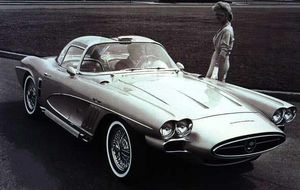.
Corvette XP-700 concept
| 1960 Corvette concept | |
|---|---|
| General Motors | |
| aka | XP-700<ref>"XP" was a GM designation for experimental (XP) concept cars.</ref> |
| Production | concept |
| Class | Sports car |
| Body type | 2-door, 2-seater, canopy coupé |
| Length | 190 in. (est.) |
| Width | 72.8 in. |
| Height | 51 in. |
| Wheelbase | 102 in. |
| Curb weight | 3,500 lbs. (est.) |
| Drivetrain | Front engine, rear-wheel drive |
| Engine | Chevrolet V-8 OHC |
| Transmission | 4-speed manual |
| Power | 230 bhp |
| Designer / builder | William L. "Bill" Mitchell |
| Predecessor | 1958 Corvette |
| Successor | 1961 "XP-755" Mako Shark |
The Corvette XP-700 was a one-off, two-seater sports car that was intended by General Motors to be a concept but was actually a prototype that used components from available Corvettes at the time and was modified with subtle embellishments to the body style. It was built under the personal supervision of GM Chief Designer William L. "Bill" Mitchell<ref>GM Store 1958 Chevrolet Corvette XP-700 - ©2006 General Motors, All Rights Reserved</ref> (1912-1988) and driven by him for the first year of its life, after which it was redesigned and put on public display the following year. The XP-700 was a two door, canopy coupé that incorporated a Grand Prix-inspired body over a conventional chassis. It was debuted officially to the public in 1960. In 1961 the chassis was re-used for building its successor, the 1961 Mako Shark<ref>Digital Corvettes "According to Mark Jordan, son of GM designer Charles M. Jordan, the XP-755/Mako Shark was built on the XP-700, explaining it's disappearance". Forum entry on 06-14-2005, 02:16 PM - Copyright ©2000 - 2007, Jelsoft Enterprises Ltd. and © 2003-2007, DigitalCorvettes.com, Inc. - All Rights Reserved</ref>.
Design
The design of the XP-700 was built upon the 1958 Corvette, borrowing chiefly the fibreglass monocoque that was fitted to a box-tube chassis to start with. Setting it apart from the '58 it freatured wilder visual cues that carried over to later models, and boasted dual headlights and a duck-tail rearend. Unique to this 'Vette' however was the protruding grill snout that looked similar to a 1957 Ferrari 410, one of the more successful race cars in Europe, and a typical Grand Prix look at the time. As was the fashion with most concepts conceived of in the mid to late 50s, the most breakaway feature on this 'Vette' was the futuristic cockpit enclosure, a one-piece plastic canopy that was sprayed with vaporized aluminium<ref>Corvette Center Bruce Glueck Chevrolet's, Corvette XP-700 - © Bruce Glueck Chevrolet 2005</ref> to restrict solar penetration, and a rearview periscope<ref>The Idaho Corvette Page Corvette XP-700 - Copyright © 2005</ref> that was accessed through an opening in the roof. Just in front of the wind screen, on both front fenders, were functional air scoops similar to those on the Pontiac Bonneville Special, and below conventional doors were fitted the "sidewinder" exhaust pipes.
Power plant
The XP-700 was a front engine, rear wheel drive car with the motor mounted under a conventional hood that swung forward. Power came from a conventional Chevrolet 283 in³ small-block engine that was fitted with cast iron heads, factory manifolds, and was naturally aspirated through a single, four-barrel carburetor. Total output was 230 bhp at 4800 RPM. Gearing was controlled through a 4-speed manual transmission.
| Engine name | Engine type | Displacement in³ ( L) | Output bhp (kW) @ RPM | Torque Ft-Lbs (Nm) @ RPM | Carburetor series (bbl) |
| "Small-block" | V-8 | 283 (4.6) | 230.00 (204) @ 4800 | 300 (NA) @ 3000.00 | Rochester Quadrajet (4) |
Trivia
- The XP-700 was featured in Motor Trend Magazine in February of 2002.
Footnotes
<references/>
See also
| Wikimedia Commons has media related to: |

